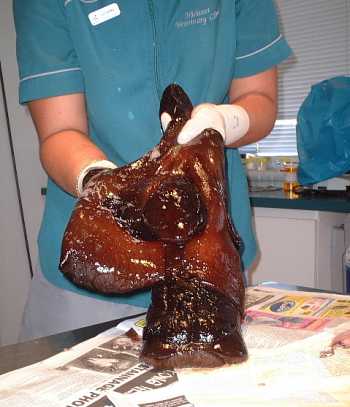Giant Sea Hare poisoning dogs!
March 6, 2002
From: Peter Taylor

I am a practising veterinarian in Geraldton Western Australia. Over the last week several dogs have presented with convulsions and respiratory failure after consuming what could be either nudibranches or Sea Hares (Aplysia). All poisonings have occurred in dogs after coming into contact with these organisms which were washed up on the beach in their thousands. I understand that some of these organisms can incorporate other toxins into there own systems so possibly we are looking at a cocktail of toxins from algae or other marine organisms as the contributing poisons. If you have any knowledge of this scenario occurring anywhere else could you please let me know. The toxins are causing convulsions, respiratory depression and death in some cases. I have attached some images for id if possible. The locality is Geraldton, Western Australia, 400kms north of Perth. Only one beach seems to have the toxic hares.
Yours sincerely
Peter Taylor
midwestvet@wn.com.au
Taylor, P., 2002 (Mar 6) Giant Sea Hare poisoning dogs!. [Message in] Sea Slug Forum. Australian Museum, Sydney. Available from http://www.seaslugforum.net/find/6360Dear Peter,
The animal is a Sea Hare which is known as Aplysia gigantea on the west coast of Australia and Aplysia extraordinaria on the east Coast. Some day we will sort out the taxonomy.
Most species of Sea Hare wash up and die at the end of their life cycle, sometimes in large numbers as you are experiencing at the moment. [See Mass Mortality page.] There is quite a lot of background information on Sea Hares on the Forum. If you go to the Sea Hares page you will find plenty of links to relevant pages.
I have never heard of them causing problems like you describe but there are three possible causes I can think of.
•1. Firstly there is not an awful lot known about the 'natural products' chemistry of these beasts but there is a list of references on the Forum. Avila, 1995 and Johnson & Willows, 1999 are probably the most useful references for a general overview. It is possible they have sequestered some nasty molecule from their algal food but these molecules are usually considered to be distasteful and so a defensive mechanism against predation. But I guess dogs tend to eat things we would consider very distaseful
• 2. Sea Hares produce 3 secretions - a purple ink, a white ink, and a viscous colourless secretion from an organ called the opaline gland. Little is known of their function. However the secretion from the opaline gland has been reported to contain some biologically active molecules. Injecting the opaline secretion from Aplysia juliana into crabs has been reported to cause paralysis and death - but this is very preliminary work and may have no relevance to mammals.
3. A third possibility is that the dogs have been affected by a micro-organism in the gut or digestive gland of the Sea Hares. Have a look at my reply to a question about a related Sea Hare, Dolabella auricularia. In that case a couple were hospitalised after eating sea hares. One suggestion is that it is possible that the organism that causes siguatera poisoning is perhaps more widespread than realised and it, or something similar, could sometimes inhabit the digestive gland of Sea Hares.
Unfortunately it is mostly conjecture at this stage. Sea Hare 'washups' or 'mass mortality events' are fairly short-lived. Apart from trying to keep the dogs off the beach until the Sea Hare episode is over I can't really offer much advice. If you find any more information - or a cure for the dogs - please let us know. It may prove handy some tiime in the future.
Best wishes,
Bill Rudman
Related messages
-
Swimming Sea Hare from Western Australia
From: Stephen Clifford, May 5, 2010 -
Giant Brown Sea Hares at Fremantle, Western Australia
From: Joanna Robertson, March 3, 2010 -
Sea hares at Perth, W. Australia.
From: John Gorter, February 18, 2010 -
Re: Big Sea slug from Western Australia
From: Dawn Skinner, March 11, 2009 -
Poisonous Sea Hares in Western Australia
From: Helen Oates, February 23, 2009 -
Big Sea slug from Western Australia
From: Suzy Galloway, March 31, 2008 -
Sea Hare poisoning in Western Australia
From: Dr Tony Pusey, March 11, 2005 -
Poisonous Sea Hares
From: Sue Lennard , March 27, 2003 -
Wilbur recovers from Sea Hare poisoning
From: Sandra & Andy Rose, March 19, 2003 -
Sea Hare - toxic to dogs
From: Sandra & Andy Rose , March 18, 2003 -
Sea hares in Western Australia
From: Joyce Mort., March 17, 2003 -
Dog-poisoning Sea Hares make the news
From: Bill Rudman, February 27, 2003 -
Re: Dog-poisoning Sea Hares
From: Gwyneth Ingham, February 26, 2003 -
Re: Giant Sea Hares poisoning dogs
From: Sharon Wood, February 24, 2003 -
Re: Giant Sea Hare poisoning dogs!
From: Sharon Wood, February 21, 2003 -
Re: Dogs and Sea Hares
From: Kim Trotter, February 21, 2003 -
Sea Hares killing dogs in Western Australia
From: Kim Trotter, February 20, 2003 -
Mystery brown-black slug from West Australia
From: Julie Robertson, January 31, 2003 -
Sea Hare? swimming
From: Jessica Vivien , January 18, 2003 -
Aplysia from West Australia
From: Masoud Abadi, December 31, 2002 -
Aplysia neurotoxins
From: Cary Rogers , March 27, 2002 -
Re: Sea Hare poisoning
From: Cary Rogers , March 10, 2002 -
Re: Sea Hare poisoning
From: Cary Rogers, March 8, 2002 -
School- based sea hare research
From: Amy Dohnt, March 6, 2002
